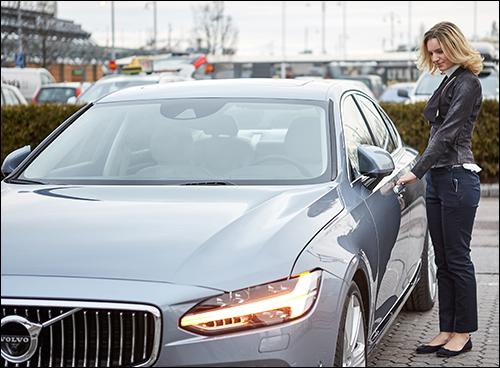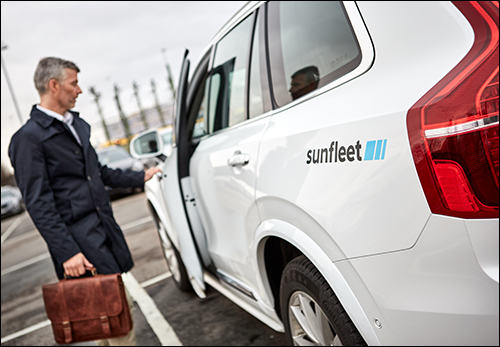A number of companies, including Tile and Trackr, sell Bluetooth tags that that consumers can affix to objects they often misplace, such as their car keys. Using a smartphone app, consumers can make the tags chirp to help them hone in on the keys’ whereabouts. Last week, Volvo Car Group announced plans to solve the pesky lost-key problem for good, by removing the need for car keys altogether.
Starting this spring, Volvo will begin a pilot test to evaluate a Bluetooth-based application that will enable a driver running Volvo’s On Call smartphone app to unlock her car as she approaches it, and then allow her to start the vehicle’s ignition once she is inside. So long, car keys—although Martin Rosenqvist, Volvo’s director of new cars, assures IOT Journal that once the technology is rolled out to consumers, vehicles will still come with a set of physical keys.
The pilot will involve between 10 and 20 Volvo vehicles that are part of the fleet of rental cars offered by a car-sharing service called Sunfleet—that is, out of the 1,000 Volvo cars that comprise this fleet, and which are located in all major metro areas throughout Sweden. (Sunfleet is owned by Hertz Sweden, of which Volvo is a partial owner.) “We have a lot of international employees flying in [to the headquarters in Gothenburg], mainly from Belgium, where we have a factory in Gent. They usually land on Monday and fly back on Friday,” Rosenqvist says. These employees will be testing the keyless-entry and ignition features in the On Call app, which will be available both on the iOS operating system and on select Android handsets—the latest Samsung models, as well as two HTC models. A Microsoft Windows phone version is forthcoming. Rosenqvist says he does not yet have an exact number of these workers who will be involved in this initial pilot.
Currently, Sunfleet users access the car-sharing service’s vehicles by holding an RFID card up to a reader mounted near the windshield. Once inside, they enter a PIN code into the locked glovebox in order to access the car’s key.
Volvo is deploying a firmware upgrade to the pilot cars, Rosenqvist says, which is required to initiate communication to a car’s Bluetooth radio and the app running on the driver’s phone. The company also needs to install additional Bluetooth antennas in the vehicles, which enable the system to know the phone’s precise location in relation to the car. “We have to get the [driver’s] positioning right,” he explains. “The car needs to detect that you are approaching the car, and that you are close enough to open the car door—and even that you are on the driver’s side of the car—and it needs to know your position inside the car” before the ignition is enabled.
The pilot, which will initially involve only Volvo personnel, does not yet have a set timeline. However, Volvo plans to expand the pilot to include cars driven by consumers starting next year; Rosenqvist could not say whether that will initially be available to drivers with private cars, or only to consumers who use the Sunfleet car-sharing service.
According to Volvo, the On Call app could be used to enable drivers to grant others—such as family members, friends or mechanics—the ability to access and drive their cars, by using the app to issue them digital keys. These other users would need to install the On Call app on their phones.
In the future, Volvo plans to work with car-rental companies to offer their customers digital keys via a smartphone app that will enable them to unlock and start Volvo rental cars. Frequent fliers who have found themselves in long car-rental queues would likely embrace this app.
Security—And Concerns
Much like beacons used to trigger smartphone apps in retail stores, the Bluetooth radio inside the pilot cars would constantly send a ping, looking for the driver’s phone. And while Rosenqvist says he could not share many details for security purposes, the digital key and lock combination that pairs a phone to a car and enables the keyless functions is encrypted.
Dan Lohrmann, who worked for the National Security Agency and was the first chief security officer for the state of Michigan before accepting his current position as chief security officer at security consultancy Security Mentor, says using a smartphone app to enter and start cars “will certainly add a convenient high-tech feature for Volvo that may sell cars.”
However, Lohrmann points to known security concerns regarding how Bluetooth technology has been insecurely deployed in consumer products in the past. Beyond encrypting transmissions between the car and phone, he notes, it is vital to ensure that the software powering the application is adequately updated and patched on an ongoing basis.
Plus, Lohrmann adds, Volvo will not be able to account for the security habits of drivers. “On vacation in Florida last week, I saw three lost smartphones handed into a resort check-in desk in less than one hour,” he recalls. “Two of the three smartphones had no password protection. We need vastly improved public awareness of the importance of securing smartphones.”
Rosenqvist asserts that Volvo will not release this new functionality immaturely. “We see safety as our core value,” he says, “so this application will not be on the market unless it’s just as safe as the functions we currently enable in the On Call app.”
Those existing On Call phone functions, which involve using the cellular network to send commands to a car, include the ability to start the vehicle’s engine remotely, and to set the heating or cooling system so that the car reaches a comfortable temperature before the driver enters. The app also lets drivers flash a vehicle’s headlights or trigger the horn to help them locate it in a crowded parking lot.
In addition, Volvo offers an in-car delivery service in Sweden, through a partnership with postal service PostNord, online toy store Lekmer.com and online grocery retailer Mat.se. Rosenqvist explains how it works:
“I get all my groceries delivered to the boot of my car by using a remote digital allowance. I book it all online, and then I have a timespan—say, between 2 and 4 in the afternoon—during which I request delivery. I provide the approximate address where my car is parked, and the delivery service receives a one-time digital key. When the delivery person gets close to the vehicle, they receive a message with the exact position of the car, and they can prompt the car to open its boot and place the order inside.”



